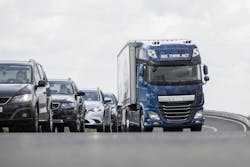In our “In Brief,” page 34, we noted some of the recent developments that are changing the face of mobility, including transit systems partnering with transportation network companies, self-driving buses being tested and even the development of personal taxi drone tests.
From the time we put that together to the time we went to press, there were numerous additional stories that came out. Seems apropos that this revolutionary shift in transportation technology moves at a faster pace than print media.
In June I had the opportunity to witness some of this technology firsthand. At a global press event, ZF presented its latest advances in collision avoidance technology. The Evasive Maneuver Assist was jointly developed by Wabco and ZF, featuring Wabco’s braking, stability and vehicle dynamics control systems on vehicles with ZF’s active steering technology.
Sitting in a semitruck as it brakes, accelerates and passes around a car on the road by itself is pretty amazing as you watch the wheel and pedals take over on its own.
In the company of other media from various industries, there were plenty of “Optimus Prime” jokes made, but we were also discussing safety and cybersecurity. Engineers pointed out the multiple built-in redundancies of the prototype demonstration which help in assuring safety and reliability of equipment.
After riding in a car showcasing the Evasive Maneuver Assist, which utilizes Wabco’s OnGuardActive radar-only collision mitigation system, it brought to light the unique situation for public transportation.
Riding in the front passenger seat of the car headed at about 70 mph at a test obstacle I had my video running to capture the demonstration. While watching the car from the side or even when watching the video, you see the car approach an obstacle, then it swerves out of the way. Neither do justice to the force you feel as it speeds toward the obstacle and then veers off to the side to avoid a collision.
As these technologies evolve and prototype demonstrations of self-driving vehicles continue, it will show what they can do for safety and efficiency. And, what new challenges the technologies themselves hold.



